- Clone
- J1015E10 (See other available formats)
- Regulatory Status
- RUO
- Other Names
- MIG-1, MIG
- Isotype
- Mouse IgG2a, κ
- Ave. Rating
- Submit a Review
- Product Citations
- publications
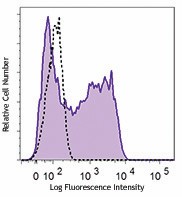
-

IFN-γ and TNF-α stimulated (overnight in the presence of monensin) human peripheral blood monocytes were fixed with the Fixation Buffer and permeabilized with Permeabilization Wash Buffer . Cells were then stained with CXCL9 (clone J1015E10) APC (filled histogram) or mouse IgG2a, κ APC isotype control (open histogram).
| Cat # | Size | Price | Quantity Check Availability | Save | ||
|---|---|---|---|---|---|---|
| 357905 | 25 tests | 120€ | ||||
| 357906 | 100 tests | 271€ | ||||
Chemokine (C-X-C motif) ligand 9 (CXCL9), also known as monokine induced by gamma interferon (MIG), is a small cytokine belonging to the non-ELR (lacking a Glu-Leu-Arg motif in the N-terminal region) motif CXC chemokines. CXCL9 shares the CXCR3 with CXCL10 and CXCL11, and these ligands differ in their receptor-binding and activating properties; CXCL11 is more potent than CXCL10 and CXCL10 is more potent than CXCL9. Some studies have revealed that these ligands have redundant functions in vivo; other studies have demonstrated that the three CXCR3 ligands can collaborate and even compete with each other.
CXCL9 is mainly produced by activated macrophages and some cancer cells. Functioning as a chemoattractant, CXCL9 attracts CXCR3-expressing cells (such as a subset of circulating T cells, B cells, and natural killer cells) into inflammatory sites. Like other chemokines, CXCL9 is also able to elicit intracellular calcium flux and activate PI3K and MAPK. It participates in multiple immune and inflammatory responses by affecting cell growth, movement, or activation.
Product Details
- Verified Reactivity
- Human
- Antibody Type
- Monoclonal
- Host Species
- Mouse
- Immunogen
- Recombinant human CXCL9.
- Formulation
- Phosphate-buffered solution, pH 7.2, containing 0.09% sodium azide and BSA (origin USA)
- Preparation
- The antibody was purified by affinity chromatography and conjugated with APC under optimal conditions.
- Concentration
- Lot-specific (to obtain lot-specific concentration and expiration, please enter the lot number in our Certificate of Analysis online tool.)
- Storage & Handling
- The antibody solution should be stored undiluted between 2°C and 8°C, and protected from prolonged exposure to light. Do not freeze.
- Application
-
ICFC - Quality tested
- Recommended Usage
-
Each lot of this antibody is quality control tested by intracellular immunofluorescent staining with flow cytometric analysis. For flow cytometric staining, the suggested use of this reagent is 5 µl per million cells in 100 µl staining volume or 5 µl per 100 µl of whole blood.
- Excitation Laser
-
Red Laser (633 nm)
- RRID
-
AB_2566033 (BioLegend Cat. No. 357905)
AB_2566033 (BioLegend Cat. No. 357906)
Antigen Details
- Structure
- A member of the alpha subfamily of inflammatory chemokines.
- Distribution
-
Activated macrophages and some cancer cells.
- Function
- Attracts CXCR3-expressing cells, such as a subset of circulating T cells, B cells, and natural killer cells.
- Ligand/Receptor
- CXCR3
- Cell Type
- B cells, Macrophages
- Biology Area
- Cell Biology, Immunology, Signal Transduction
- Molecular Family
- Cytokines/Chemokines
- Antigen References
-
1. Groom JR, et al. 2012. Immunity 37:1091.
2. Loetscher P, et al. 2001. J. Biol. Chem. 276:2986.
3. Jones D, et al. 2000. Blood 95:627.
4. Liao F, et al. 1995. J. Exp. Med. 182:1301. - Gene ID
- 4283 View all products for this Gene ID
- UniProt
- View information about CXCL9 on UniProt.org
Related FAQs
Other Formats
View All CXCL9 Reagents Request Custom Conjugation| Description | Clone | Applications |
|---|---|---|
| PE anti-human CXCL9 (MIG) | J1015E10 | ICFC |
| APC anti-human CXCL9 (MIG) | J1015E10 | ICFC |
| TotalSeq™-B1243 anti-human CXCL9 (MIG) | J1015E10 | ICPG |
| TotalSeq™-C1243 anti-human CXCL9 (MIG) | J1015E10 | ICPG |
Customers Also Purchased
Compare Data Across All Formats
This data display is provided for general comparisons between formats.
Your actual data may vary due to variations in samples, target cells, instruments and their settings, staining conditions, and other factors.
If you need assistance with selecting the best format contact our expert technical support team.
-
PE anti-human CXCL9 (MIG)
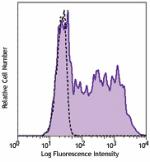
IFN-γ and TNF-α stimulated (overnight) human per... -
APC anti-human CXCL9 (MIG)
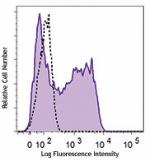
IFN-γ and TNF-α stimulated (overnight in the pre... -
TotalSeq™-B1243 anti-human CXCL9 (MIG)
-
TotalSeq™-C1243 anti-human CXCL9 (MIG)
 Login / Register
Login / Register 









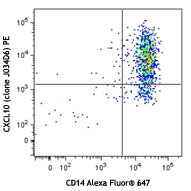
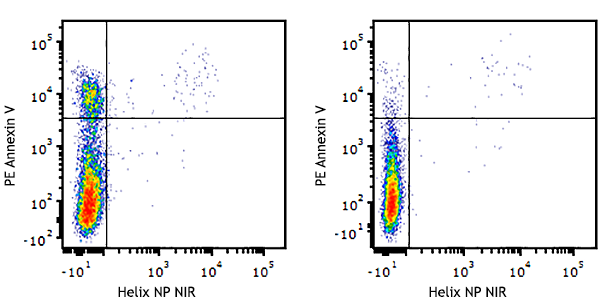
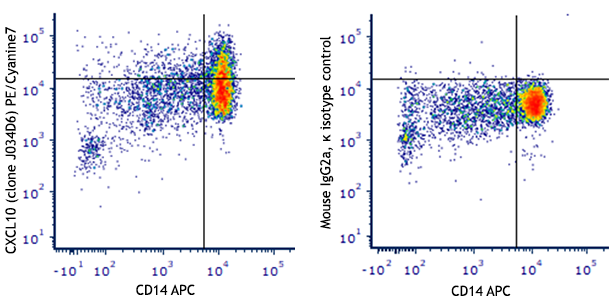
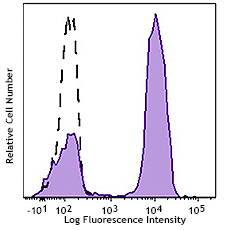



Follow Us